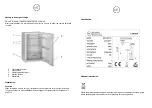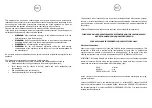
Avoid locating your refrigerator near a heat source, e.g. cooker, boiler or radiator. Also
avoid direct sunlight in sun lounges or conservatories. If you are placing your refrigerator in
an out-building such as a garage or annex ensure that the refrigerator is placed above the
damp course, otherwise condensation will occur on the refrigerator cabinet.
Never place the refrigerator in a wall recess or into fitted cabinets or furniture. When your
refrigerator is working, the grill at the back may become hot and the sides warm. To aid the
air flow around the refrigerator keep ventilation openings, in the appliance enclosure or in
the built in structure, clear of obstruction. It must also be installed so that there is at least
7cm (2 ¾”) of free space at the back, sides and above the refrigerator.
The refrigerator door can be fitted to open to either the right or the left, depending on its
location.
Levelling the Refrigerator
Once the refrigerator is sited in its final location, make sure it is level. To do this use the two
levelling feet at the front of the refrigerator. (If the refrigerator is not level, the doors and
magnetic seal alignments will be affected.)
Cleaning before use
Wipe the inside of the refrigerator with warm water using a soft cloth. Wipe completely dry
before replacing the shelves and baskets.
Before using your Refrigerator
Check that you have your power outlet is compatible with the plug supplied with the
refrigerator. If not, see the section called ELECTRICAL CONNECTION at the back of this
booklet.
DO NOT SWITCH ON UNTIL TWO HOURS AFTER MOVING THE REFRIGERATOR to allow the
coolant fluid time to settle.
Before placing any food in your refrigerator, turn the refrigerator on and wait for 24 hours,
to make sure it is working properly and to allow the refrigerator to fall to the correct
temperature.
Using Your Refrigerator
Switching on your refrigerator:
1)
Before connecting the refrigerator to the mains supply make sure that the
Temperature Control located inside the refrigerator is set between
3
and
4
, which
is the correct setting for use in a room of average temperature.
2)
Wait 24 hours before placing food in the cabinet to allow for the refrigerator to fall
to the correct temperature.
Adjusting the temperature
The internal temperature of your refrigerator is controlled by the Temperature Control.
There are 6 settings. Position
6
makes the refrigerator coldest. Position
1
makes it the
warmest. To adjust the temperature, turn the Temperature Control to the preferred setting.
The temperature of the refrigerator is best maintained around 0
C to +5
C. Avoid setting
the thermostat too high otherwise this may reduce the temperature to a point where certain
fresh foods may begin to freeze.
Noises inside the Refrigerator
If you have not owned a refrigerator before, you may notice that it makes some rather
unusual noises. Most of these are perfectly normal, but you should be aware of them!
GURGLING, WHOOSHING
These noises are caused by the circulation of the refrigerant liquid in the cooling system. It
has become more pronounced since the introduction of CFC free gases. This is not a fault
and will not affect the performance of your refrigerator.
HUMMING, PURRING OR PULSATING
This is the compressor motor working, as it pumps the refrigerant around the system.
Cleaning
Cleaning inside the Refrigerator
You should clean the refrigerator internally with warm water using a soft cloth. Wipe the
refrigerator dry before replacing the food. Plug in and switch on the mains supply.
Cleaning the drainage filter
The drainage hole which is located at the back of the compartment can get blocked and
affect the automatic defrost function. You can unblock it using a cotton bud, pipe cleaner or
drinking straw (don’t suck!).
Cleaning the outside of the Refrigerator
Use standard furniture polish to clean the refrigerator exterior. Make sure that the doors are
closed, to prevent polish getting on the magnetic door seal or inside. The grille of the
condenser at the back of the refrigerator and the adjacent components can be vacuumed
using a soft brush attachment.
DO NOT use electrical appliances inside the food storage compartments of the appliance,
unless they are of the type recommended by the manufacturer.
Cleaning tips
• Defrost and clean when food stocks are low.





